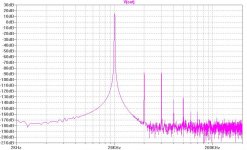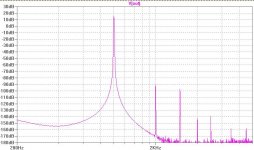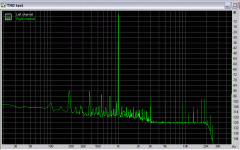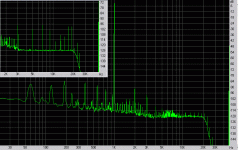vasyachkin said:however why assume that if an amp has less overall distortion that the distortion must be uglier ?
Single number distortion specs are meaningless. The actual distortion spectra can tell you a lot. The source for 4th and higher order distortion components is most often feedback. The ear can pull out higher order distortion components orders of magnitude lower than the lower orders. ie a 5th ot 6th order component may be detectable even if over a 100 times lower in level -- an amp with 1% 2nd order and nothing higher wouls have lower audible distortion than one with a 0.01% 5th order component. (Note: those numbers are PFA just to illustrate)
As well one has to consider that one has to mesure the distortion with the actual loudspeaker present, since under a real load the amps distortion can be 100s of times higher than into a resistor.
dave
MJL21193 said:Looking at the scale the higher harmonics are about -100db, including the 4th. That's a long way down.
Are you sure this is hard to listen to?
That is quite far down, but those order harmonics are not natural and the ear/brain is amazingly good at detecting them.
dave
planet10 said:
That is quite far down, but those order harmonics are not natural and the ear/brain is amazingly good at detecting them.
dave
Subtract from that the measuring devices native distortion (in this case a sound card) and that drives it down even further.
This is a relatively high power class AB amp. That test was taken at ~4 watts output.
R-Carpenter said:Blind test have proven it number of times. I have been through about 8 blind tests, listening to the amps ranged in the price between $300 and close to $7000. No audible difference was found (5 more people participated in the tests, tests were done on 2 pairs of commercial speakers, ranged between $4500 and $5000 in price).[/quoite]
What kind of tests? ABX?
I always have trouble explaining why... here is a quote from SY.
The ABX test was succesfully used to show there is no audible difference between different coupling capacitors.
That is incorrect, and in fact impossible. But a common misconception, and one which has led to some remarkable audiophile lore.
NO TEST can prove a negative. The correct way to describe the negative results of any test like this (whether ABX or any other double-blind format) is that "under the conditions of this test, listeners were unable to distinguish one capacitor from another by sound alone." That does NOT mean that all capacitors are audibly indistinguishable to all listeners under all circumstances, and if the authors of the test you describe were competent, I'll bet that's how they worded their conclusion.
dave
A friend once mentioned to me "The speaker/crossover is part of the amplifier as it's attached to the output stage, but has influence on the entire operation because of interstage interactions and global feedback." I'd tend to agree.
I've noticed that (in a particular instance) one amplifier can drive one pair of speakers well and another poorly. And another amplifier can drive the same 2 pairs of speakers both well. Audibly and repeatably. Both SS and both more than 10 years old now.
I don't have the ears (or don't consider I have) to distinguish the n-th degree of sound quality, but different amplifiers can and will sound different on the same speaker. Not all, and not by a large margin (in many cases), but more than 1%.
And it's probably a different story with tube gear, but I don't own/listen to that stuff mostly, so I can't comment.
I've noticed that (in a particular instance) one amplifier can drive one pair of speakers well and another poorly. And another amplifier can drive the same 2 pairs of speakers both well. Audibly and repeatably. Both SS and both more than 10 years old now.
I don't have the ears (or don't consider I have) to distinguish the n-th degree of sound quality, but different amplifiers can and will sound different on the same speaker. Not all, and not by a large margin (in many cases), but more than 1%.
And it's probably a different story with tube gear, but I don't own/listen to that stuff mostly, so I can't comment.
Cloth Ears said:A friend once mentioned to me "The speaker/crossover is part of the amplifier as it's attached to the output stage, but has influence on the entire operation because of interstage interactions and global feedback." I'd tend to agree.
And it's probably a different story with tube gear, but I don't own/listen to that stuff mostly, so I can't comment.
Hi Jon,
Well designed amps take into consideration what the load will be. A well designed crossover in a typical 2-way or 3-way speaker shouldn't present much of a challenge for a well designed amp, providing the impedance is correct.
Most (all??) tube amps have output transformers, so the actual amp circuit is isolated from the load
MJL21193 said:Hi Jon,
Well designed amps take into consideration what the load will be. A well designed crossover in a typical 2-way or 3-way speaker shouldn't present much of a challenge for a well designed amp, providing the impedance is correct.
Agreed. But as it (amp design) is a bit of black art to me, that's about as good as I can comment. I can sometimes follow the various pieces of a discussion on electronics (when it's on a forum), but the jump from a few components to a fully fledged amplifier never imprinted itself on my synapses. Which is why I get surprised every time amps seem to sound different (read: different amps with the same speaker). I tend to listen to snare or guitar to find the biggest differences.
MJL21193 said:Well designed amps take into consideration what the load will be.
Indeed. Why the speaker cannot be considered independent of its amplifier.
dave
planet10 said:
Yes... looks like a PP amp with little or no 2nd order, but a fair amount of 4th and some higher. Anything above 3rd the ear really finds objectionable, and the lack of 2nd means the 3rd isn't as well masked. An ideal spectrum would have some 2nd, a bit less 3rd, and vanishingly small higher order components.
dave
My amp, RMI-FC100, at the same output power - 4W rms
Attachments
planet10 said:Yes... looks like a PP amp with little or no 2nd order, but a fair amount of 4th and some higher.
I didn't look closely enuff at this chart. Spectrum charts are usually produced with a linear scale so that all the harmonics are equally spaced... i just looked at the shape and didn't note that the charts posted have log scales making them trickier to interpret. Both have close to equal 2nd & 3rd. Above that John's have some much higher order spikes i'd be inclined to assign to the test gear, but need further investigation.
roender, your chart has a 20k fundemental... do you have one with a 1k fundemental?
On yours 2 is close to 3 then 4 is close to 5, and 6 close to 7. That they exist at all with a 20 k fundemental is a tibute to your amps bandwidth. If the fundemental was 1 k those last 2 might prove quite annoying.
dave
roender said:
My amp, RMI-FC100, at the same output power - 4W rms
Very nice!

planet10 said:
I didn't look closely enuff at this chart. Spectrum charts are usually produced with a linear scale so that all the harmonics are equally spaced... i just looked at the shape and didn't note that the charts posted have log scales making them trickier to interpret. Both have close to equal 2nd & 3rd. Above that John's have some much higher order spikes i'd be inclined to assign to the test gear, but need further investigation.
Sorry for the confusion Dave. Default for RMAA is log, so that's how I presented it.
Attached is the sound cards distortion (used to make the measurement on the amp).
I was trying to say that class AB is fine at low level output, with very good, low distortion sound.
Not bad to listen to at all, on any speakers.
Attachments
MJL21193 said:Sorry for the confusion Dave. Default for RMAA is log, so that's how I presented it.
Attached is the sound cards distortion (used to make the measurement on the amp).
Not a problem... i'll know to look closer next time... that card adds enuff of its own to make critical analysis tough, but it does look the source of the real high order stuff.
dave
planet10 said:
that card adds enuff of its own to make critical analysis tough, but it does look the source of the real high order stuff.
RMAA is not perfect. It gives a fair idea of of noise floor, THD, frequency response, dynamic range, IM+N, but in the end you need to deduct the sound cards performance.
It's good enough to judge an amps real world performance, as it can be tested while connected to a real speaker load.
Do you have any for tube amps? I know that tube amps have higher distortion, but it even ordered, so not as objectionable as odd ordered (even if it's at a lower value).
MJL21193 said:
I was trying to say that class AB is fine at low level output, with very good, low distortion sound.
Not bad to listen to at all, on any speakers.
Well, except Brett's, Dave's, etc.
MJL21193 said:
Do you have any for tube amps? I know that tube amps have higher distortion, but it even ordered, so not as objectionable as odd ordered (even if it's at a lower value).
Yes, that would be interesting to see. But then also include 10W, 50W and 200W spectra. So we see what can happen on musical transients. See that "magical" low power sound in action.
cheers,
AJ
AJinFLA said:
Yes, that would be interesting to see. But then also include 10W, 50W and 200W spectra. So we see what can happen on musical transients. See that "magical" low power sound in action.
I will build a tube amp some day.
As with the even ordered distortion, when a tube amp clips, it sounds better than when a SS amp clips. All part of the glorious tube sound.
Still, 5 watts into an efficient speaker should be enough for normal "sane" listening.
Unfortunately, I'm insane.

MJL21193 said:Do you have any for tube amps? I know that tube amps have higher distortion, but it even ordered, so not as objectionable as odd ordered (even if it's at a lower value).
Not of our own stuff, but i can dig some up.
Here is one... (i've seen reference to the level, but can't remember)... this is a Class A differential amp based on an ST70.
An externally hosted image should be here but it was not working when we last tested it.
SE amps will typically have more 2nd and less of everything else. 2nd can be quite large before audible, 3rd is OK as long as the amount of 2nd is higher, 4th, 5th, ... are where things get annoying.
dave
MJL21193 said:So, hypothetically, if I were to factor in the sound cards high order distortion and subtract that from the amps distortion, I'd end up with something like this:
This has a very similar profile to the one you posted Dave, but at about 40db lower distortion.
Originally posted by MJL21193
when a tube amp clips, it sounds better than when a SS amp clips. All part of the glorious tube sound.
Yes, I'm aware of that. See it quoted often by tube enthusiasts. With a "high power" say 200w lo-fi SS amp vs a "low power" say 3w high-fi tube amp driving the same load, when will "when" happen?
Originally posted by MJL21193
Still, 5 watts into an efficient speaker should be enough for normal "sane" listening.
Unfortunately, I'm insane.
Well, I think it has very little to do with sanity and very much to do with program transients. Regardless of the efficiency of the loudspeaker, 5 watts is silly IMHO, when it sounds no better than 50 or 500, except in the imagination. Unless its for your alarm clock speaker, to snap you out of that imagination
cheers,
AJ
- Status
- This old topic is closed. If you want to reopen this topic, contact a moderator using the "Report Post" button.
- Home
- Amplifiers
- Solid State
- An Amp Sonics side-thread



